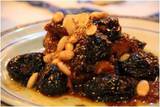Merlot, its signature characteristics and a versatile food match!
Although we all know about the typical differences between Merlot, Cabernet Sauvignon, Cabernet Franc and Syrah, when it comes to a blind tasting, and especially if the wines have maturation characters, then the differences are sometimes not so clear and obvious. Merlot has flavours of red and black fruits (raspberry, black cherry, and plum), graphite, clove, leather, caramel and cedar. However, these basic characters will vary depending on the nature of the vintage, the terroir and how the wine is made. Cool climate Merlot can be fleshy and have a greater mineral influence. Furthermore, the tannins tend to be more evident and the earthy, leather and tobacco characters can be more noticeable. In the case of hot climate Merlot, these wines are more fruit driven and the tannins are less obvious and in some cases give a hint of sweetness. Other flavours found in hot climate Merlot are rich black fruits, mocha, chocolate and perhaps the presence of spicy characters. When fully ripe, Merlot can reach high alcohol levels and lower levels of acidity compared to Cabernet Sauvignon.
The origin of Merlot is regarded as being relatively recent as it only started to be recorded in the literature from around the end of the 18th century, just before the French Revolution. The parents of Merlot are now known to be Cabernet Franc and a little known cultivar called Magdeleine Noire des Charentes. This grape had its origins in the central part of France (around Charentes) and would ripen relatively early compared to other red varieties at around mid to late July. It is probably this origin that now gives Merlot earlier ripening characteristics and makes it suitable in grape growing areas that struggle to consistently ripen Cabernet Sauvignon to an appropriate level.
In some circles, Merlot is not regarded as a wine of great longevity. But then some of the world’s most renowned wines are based on Merlot and come from the great growing areas of Pomerol and St Emilion in the Bordeaux area of France. Wines like Petrus, Le Pin and Lafleur are all Merlot dominant. The clay soils of Pomerol are regarded as one of the key factors that make Merlot so elegant and rich and impart flavours of earthiness, and spice often with a mineral tinge. Merlots from this area can easily age for 25 years plus.
One of the compounds found to distinguish Merlot from Cabernet Sauvignon is furaneol (4-Hydroxy-2, 5 dimethyl-3(2H)-furanone) or HDMF which is linked to the caramel descriptor. This compound also gives sweet fruity characters and it has a relatively low odour threshold at around 20 µg/kg of water. Furaneol occurs in the grape berries naturally, but can also arise from fermentation processes. Furaneol is also found in a range of foods including pineapple, strawberries, as well as beef broth, coffee beans, bread crusts and roasted sesame seeds. Furanone often results from the cooking of fruit and meats and occurs when sugars and amino acids are heated (this is referred to as the Maillard reaction). Similar compounds may also arise during the toasting of oak barrels.
Another compound typically found in Bordeaux red varieties (Merlot, Cabernet Sauvignon and Cabernet Franc) is beta-ionone and this component provides the character of violets. Some evidence suggests that beta-ionone may decrease during maturation. The interesting thing about beta-ionone is that an individual’s sensitivity to it is determined by their individual genetics. Australian scientists showed that the sensitivity to this compound correlated to the occurrence of specific individual genes.
Merlot with its lower acid content and softer tannins tends to match well with lighter style meats and lightly spiced dark meets. It tends not to go so well with fish or leafy vegetables unless they are braised or baked. For cooler climate Merlot that have less of the ripe fruit flavours and are fleshy then flavours of fennel, eggplant, broccoli, onions, and garlic will all go well. Where a wine is from warmer climates and has a heavier oaked character or fruit sweetness then duck, lamb with ripe black olives and thyme will be ideal. Merlot will also match with prawns or scallops wrapped in bacon which is most likely due to the production of volatile compounds arising from the Maillard reaction such as furaneol.
As Merlot ages and the maturation characters of chocolate, tobacco and dried fig develop then this is in part attributable to the hydrolysis of norisoprenoids. These components are derived from pigments in the grape skins. Aged wines from hot climates with lots of fruit flavours and maturation characters will be a sublime match with berries (cherries and cranberries), prunes and raisins – so match such wines with pork loin and cranberry sauce or lamb and prune tagines.
Happy experimenting.
John Gifford
Posted 08 August 2014
Posted: Saturday 9 August 2014

